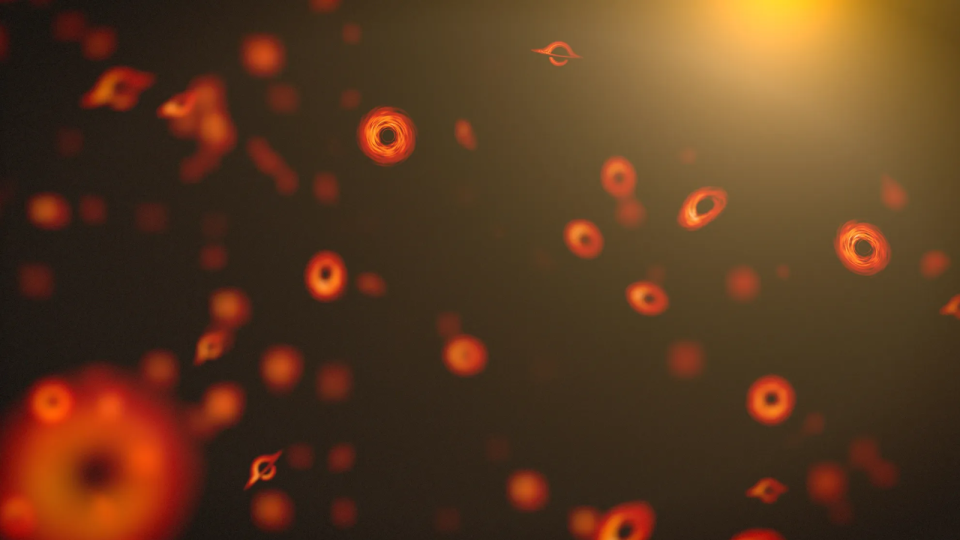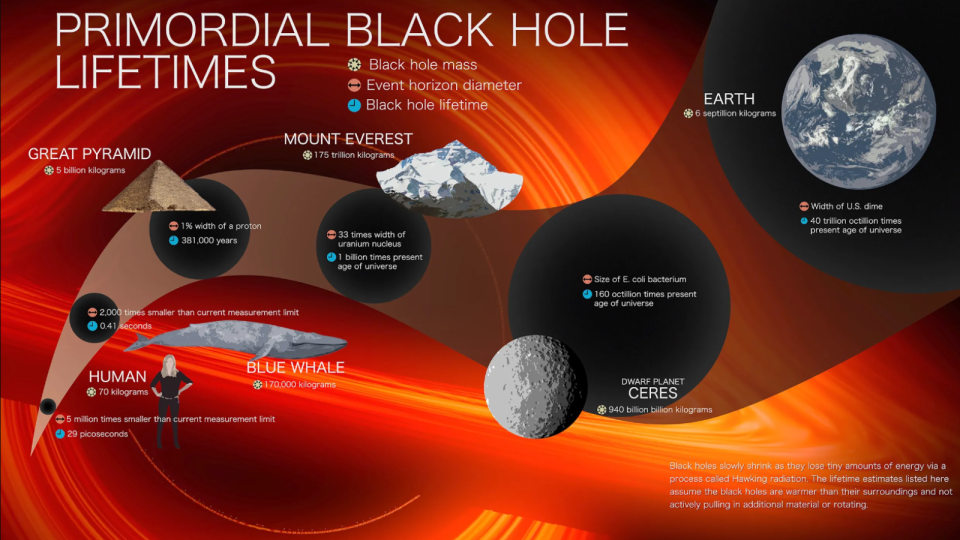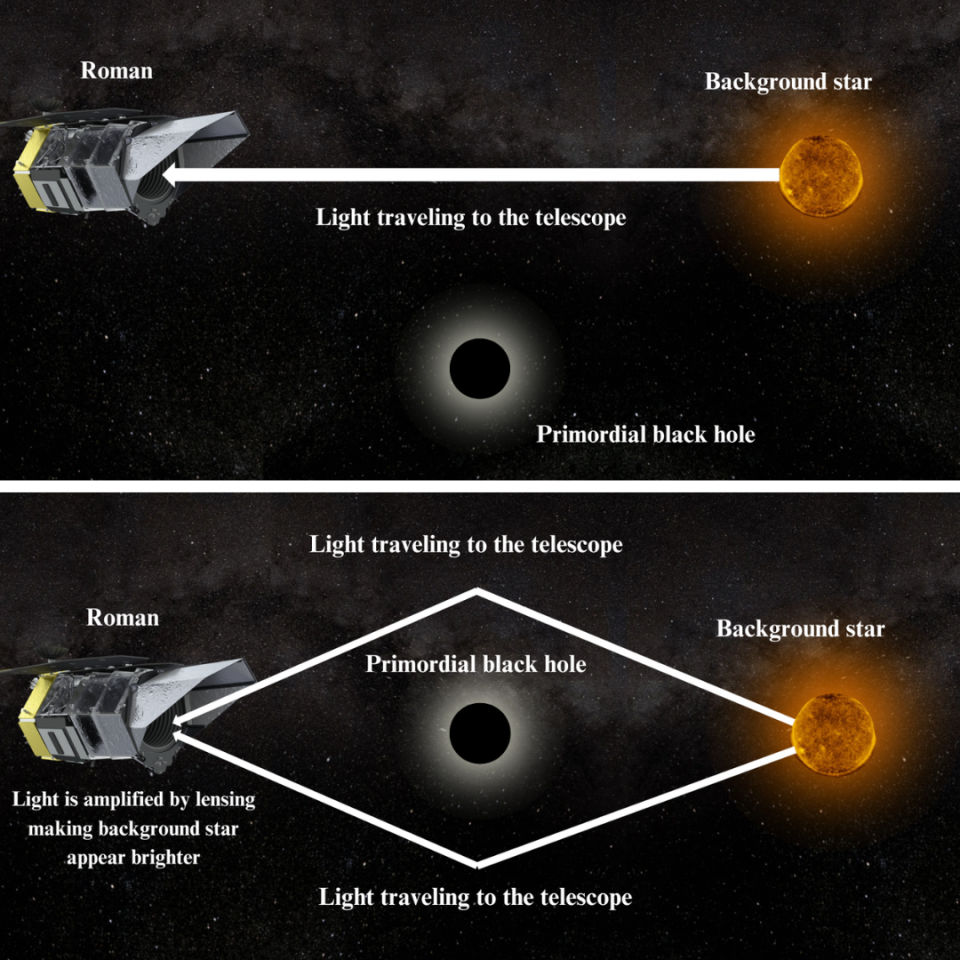Black hole week is in full swing, and to celebrate, NASA has revealed how its next major astronomy instrument, the Nancy Grace Roman Space Telescope, will hunt for tiny black holes dating back to the Big Bang.
When we think of black holes, we tend to imagine huge cosmic monsters, such as stellar-mass black holes with masses tens to hundreds of times that of the Sun. We can even imagine supermassive black holes with masses millions (or even billions) times greater than the sun, sitting at the heart of galaxies and dominating their surroundings.
However, scientists suggest that the universe may also be full of much less massive, relatively feather-light black holes with masses about the same as Earth’s. These black holes could potentially have masses as low as that of a large asteroid. Scientists also suggest that such black holes have existed since the beginning of time, approximately 13.8 billion years ago.
These black holes, aptly named “primordial black holes,” remain purely theoretical, but Roman, scheduled to launch in late 2026, could change that.
Related: Tiny black holes left over from the Big Bang may be prime dark matter suspects
“Detecting a population of Earth-sized primordial black holes would be an incredible step forward for both astronomy and particle physics because these objects cannot be formed by any known physical processes,” said William DeRocco, a postdoctoral researcher at the University of California Santa Cruz. “If we find them, it will shake up the field of theoretical physics,” Dr., who led a team investigating how Roman could reveal these ancient tiny black holes, said in a statement.
Mass matters when it comes to event horizons
The smallest confirmed black holes are stellar-mass black holes, which form when the cores of massive stars run out of fuel required for nuclear fusion. When such fusion ends, these stars collapse under the influence of their own gravity. Typically speaking, the minimum mass that a star must leave behind a stellar-mass black hole is eight times that of the Sun—anything lighter and it will end its life as a star, neutron star, or smoldering white dwarf.
However, the conditions at the beginning of the universe were very different from those of the modern age. When the cosmos was hot, dense and turbulent, it may have allowed much smaller clumps of matter to collapse, giving rise to black holes.
All black holes “start” at an outer boundary called the “event horizon”; At this point, beyond which even light cannot escape its gravitational effects. The distance of an event horizon from the black hole’s central singularity, the infinitely dense point where all laws of physics collapse, is determined by the mass of the black hole.
This means that the M87* event horizon of the supermassive black hole, which has a mass approximately 2.4 billion times that of the sun, has a diameter of approximately 15.4 billion miles (24.8 billion kilometers). A mass of 30 suns would have an event horizon approximately 110 miles wide (177 kilometers wide). On the other hand, the event horizon of an Earth-mass primordial black hole would be no wider than a dime. A primordial black hole with the mass of an asteroid would have an event horizon of width is smaller than a proton.

Scientists who support the concept of primordial black holes think that they may have been born when the universe went through a process of initial inflation that we call the Big Bang. As the cosmos moves at speeds greater than the speed of light (this is possible because nothing in space can move faster than light, space itself can move), scientists suggest that regions denser than their surroundings may collapse to form low-mass black holes.
However, many researchers do not support the concept of a primordial black hole existing in the current universe, and the reason for this is Stephen Hawking.
Do black holes die?
One of Stephen Hawking’s most revolutionary theories suggested that even black holes could not exist forever. The great physicist thought that black holes “leak” a kind of thermal radiation; this concept was later named “Hawking radiation” in his honor.
As black holes leak Hawking radiation, they lose mass and eventually explode. The smaller the mass of a black hole, the faster it must leak Hawking radiation. This means that for supermassive black holes, this process will take longer than the lifetime of the universe. However, small black holes will leak much faster and therefore die much faster.
Therefore, it is quite difficult to explain how primordial black holes can hang around without going “poof” for 13.8 billion years. If Roman manages to discover these cosmic fossils, it will make a huge contribution to the rethinking of many principles in physics.


“It will affect everything from the formation of the galaxy to the dark matter content of the universe and cosmic history,” astronomer Kailash Sahu of the Baltimore Space Telescope Science Institute, who was not involved in the study, said in a statement. said. “Confirming their identities will be a difficult task and astronomers will need a lot of convincing, but it will be worth it.”
Detecting primitive black holes will also be no easy feat. Like any black hole, these voids will be bounded by an event horizon and will neither emit nor reflect light. This means the only way to detect them would be to use a principle known as general relativity, which Albert Einstein developed in his theory of gravity in 1915.
Collaborating with Einstein
General relativity predicts that all objects with mass cause a curvature in the fabric of space and time and coalesce into a single four-dimensional entity called “spacetime.” When light from a background source crosses the warp, its path becomes curved. The closer the lenser the light passes through to the object, the more curved its path becomes. This means that light from the same object may reach the telescope at different times. This is called gravitational lensing.
When the lensing object is incredibly large, like a galaxy, the background source may appear to shift to a visible location, or even appear in more than one place in the same image. If the lensed object has a smaller mass, such as a primordial black hole, the lensing effect is smaller but can cause brightening of background sources that can be detected. This is an effect called microlensing.


Currently, microlensing is used to great effect to detect stray planets or worlds drifting in the Milky Way without a host star. This gave rise to a large population of rogues roughly the size of Earth; more than theoretical numbers; In fact, the models predict it. With this model, scientists predict that Roman will increase the detection of rogues around the Earth tenfold.
The abundance of these objects has led to speculation that some of these Earth-mass objects may actually be primitive black holes. “There is no way to distinguish between Earth-mass black holes and rogue planets on a case-by-case basis,” DeRocco said. “Roman will be extremely strong at statistically separating the two.”
RELATED STORIES:
— Nancy Grace Roman The Space Telescope will ‘rewind’ the universe. Here’s how
— How will NASA’s Rome Space Telescope hunt for lonely black holes and distant exoplanets?
— NASA’s Nancy Grace Roman space telescope will accelerate exoplanet hunting to warp speed
“This is an exciting example of what extra scientists can do with the data Roman will obtain when searching for planets,” Sahu said. “And whether or not scientists find evidence for the existence of Earth-mass black holes, the results are interesting. Either way, it will strengthen our understanding of the universe.”
The team’s research was published in January in the journal Physical Review D.